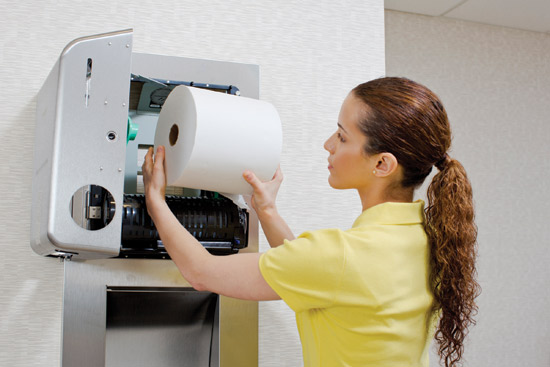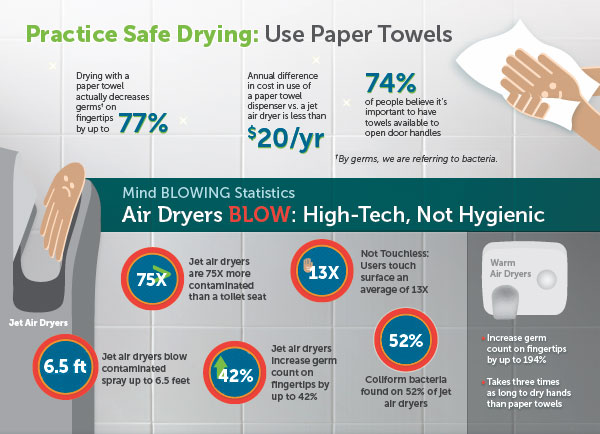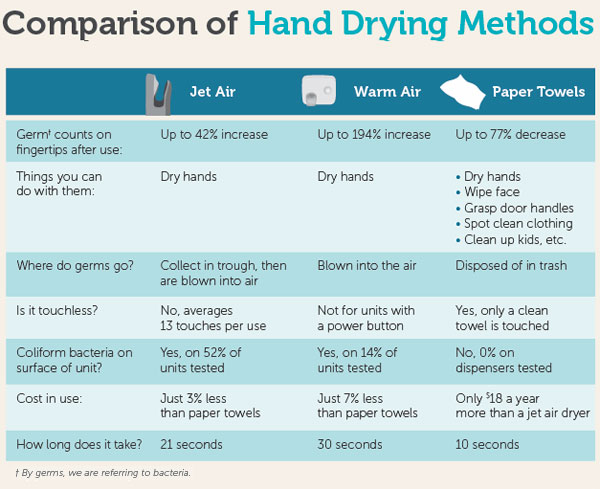Looking Good: New Paper Towel Dispenser Systems Score in Appearance, Sustainability, and User Preference
Existing Hand- and Face-Drying Systems—Promoting Hygiene
In a restroom, one of the most important functions in promoting good hygiene is hand sanitizing. The U.S. Centers for Disease Control and Prevention (CDC) has proclaimed that “hand washing is like a 'do-it-yourself' vaccine,” and can reduce the spread of diarrheal and respiratory illness. Countless other organizations have echoed the CDC's message about the value of keeping hands clean. However, to effectively complete the process and receive the full benefits of hand washing, it is imperative that hands be dried effectively, too. As experts maintain that transmitting bacteria is more likely to occur from wet skin than from dry skin, the most effective approach to hand drying can have far-reaching implications for public health.9 Substantial research has been conducted to determine the most sustainable and hygienic options. Following is a comparative discussion on hand drying via paper towels and air dryers in terms of both hygiene and efficacy.
Paper Towel Systems
Drying hands with paper towels can reduce germs substantially, and several studies have concluded that hand drying with paper towels is the best option in terms of hygiene and user preference. In 2011, the Mayo Clinic conducted The Hygienic Efficacy of Different Hand-Drying Methods: A Review of the Evidence, a study that examined the research on the hygienic efficacy of different hand-drying methods. The highlights of that study are as follows:
• Hand washing is the most important measure to reduce the burden of health care-associated infection.
• Because the transmission of bacteria is more likely to occur from wet skin than from dry skin, the proper drying of hands after washing should be an essential component of hand hygiene procedures.
• The hygienic efficacy of hand drying includes drying efficiency, the effective removal of bacteria, and the prevention of cross-contamination.
• From a hygiene viewpoint, paper towels are superior to electric air dryers.
• Drying hands thoroughly with single-use, disposable paper towels is the preferred method of hand drying in health care.
• The provision of paper towels should be considered as a means of improving hand hygiene adherence among health care workers.
In other conclusions, residual water was found to be more efficiently removed from the hands by cloth or paper towels. With just 10 seconds of drying with a single-serve towel, the residual water on the hands was minimal. Warm air dryers were much slower and required 45 seconds to reduce the residual water.10 The study also revealed that users have a strong preference for using paper towels and that “hand hygiene adherence would possibly decrease if paper towels are not available in washrooms.”
While alternative methods of hand dryers perform only one function, namely drying hands, paper towels multi task. They can be used to wipe the face, spot clean clothes, and tidy up children. Many restroom users favor the two paper-towel approach, one for drying hands and another for grasping the door handle upon exiting. Paper towels score well on other counts as well, far outstripping hand dryers. According to a comparative study of different hand-drying methods undertaken at the University of Westminster in November 2008, paper towels can do a satisfactory job in hand drying in only 10 seconds,11 and they actually show a decrease in germ counts on fingertips after use up to 77 percent.12 A study found hand dryers blow bacteria on people and throughout the restroom—up to 2 meters. Only a clean towel is touched, instead of being blown into the air as is the case with hand dryers; any germs that may gather on the towel during wiping are disposed of in the trash basket.

Photo courtesy of KIMBERLY-CLARK PROFESSIONAL*
Incorporating natural, non-tree fibers, such as bamboo and wheat straw, is another option that has been deployed to achieve sustainable paper products.
An effective paper towel system is predicated on a comprehensive maintenance system, in which staff are trained to remove the trash basket and replenish supplies of towels in a timely manner to keep restrooms comfortable and sanitary.
Air Dryers
Electric hand dryers that use heated air have been in use for decades, and have continually evolved to greener, more efficient versions. All electric hand dryers display most of their adverse environmental impact during use, specifically through energy consumption.
According to research in the aforementioned Westminster study, electric hand dryers don't dry hands as quickly as paper towels, sometimes taking up to 30 seconds to sufficiently do the job. In the process, germs are blown into the air. In terms of germ counts on fingertips after use, traditional hand dryers have shown a dramatic increase of 194 percent and a 14 percent increase in coliform bacteria on the units themselves. Not all units turn out to be truly touchless, with many being activated only via a power button, adding to the germ transmission problem. In terms of costs, they are only 7 percent less expensive than paper towels, according to the study.

Graph courtesy of KIMBERLY-CLARK PROFESSIONAL*
Newer models of high-speed dryers provide higher-velocity delivery of the same amount of air as traditional models, score better marks in hand-drying time and energy efficiency. These models have been shown to sufficiently dry hands in 21 seconds, or 9 seconds faster than their traditional counterparts. However, that accomplishment seems to come at considerable expense. Germs collect into a trough, and then are blown into the air; in fact, jet air dryers have been found to blow contaminated air up to 6.5 feet from the unit itself. While germ counts on fingertips after use show a 42 percent increase, substantially lower than that of traditional dryers, the results for the increase in coliform bacteria on the surface of the units is significantly worse—a 52 percent increase vs. 14 for traditional dryers, with research pegging the surface jet air dryers at 75 times more contaminated than a toilet seat. Further, these machines are not in sync with one of the most critical elements of retarding the spread of germs—touchlessness. In fact, they have been shown to average 13 touches per use.
The aforementioned Mayo Clinic researchers also found that “Rubbing hands while under hot-air dryers leads to greater bacterial numbers and airborne dissemination,” and that rubbing hands may cause bacteria to migrate from hair follicles to the skin surface. Jet-air driers, while drying faster than hot-air dryers, resulted in the movement of air that only led to bacteria being spread further, according to the study.
Another big challenge with hand dryers is the water that drips down to the floor from users' hands and that can also be sprayed onto walls, leaving unsightly watermarks that leave a restroom looking soiled and ill maintained. In addition to cosmetic consequences, the water can also cause distinct health and safety hazards. While water dripping to the floor from one pair of hands seems inconsequential, but multiply that by hundreds, if not thousands, of users a day in high-traffic restrooms. That can add up to substantial pools of water on the floor that can create a breeding ground for bacteria and fungi, but can also pose a substantial risk of slips and falls. The Occupational Safety and Health Administration (OSHA) maintains that accidental falls account for the majority of general industrial accidents, with more than 12,000 injury cases, annually. A great percentage of slips and falls occur on wet surfaces and, because public restrooms typically have smooth floors made of tile, linoleum, or concrete, the risk of injury from a slip and fall is high. Another concern is that water could damage restroom walls and grout. When water pools on floor, it requires more frequent and longer cleaning times in the restrooms. Some facility managers handle that by purchasing floor mats, but these too need to be maintained. Newer models do have water-collection features such as drip trays, splashguards, ceramic plates that mount to the walls and wider-mouth dryers that direct water to a reservoir.

Graph courtesy of KIMBERLY-CLARK PROFESSIONAL*









